Читать книгу Anti-Aging Therapeutics Volume XIII - A4M American Academy - Страница 56
На сайте Литреса книга снята с продажи.
BIOAVAILABILITY AND METABOLISM OF RESVERATROL
ОглавлениеA primary reason for clinical failure of compounds with promising in vitro activities is limited bioavailability. Resveratrol appears to be well-absorbed from oral mucosa, but undergoes significant first-pass hepatic metabolism after absorption from the gastrointestinal tract. In human subjects, blood levels indicate no more than 20% overall bioavailability. A randomized crossover study demonstrated that when taken with food, peak levels are delayed to 1.5 hours as compared to 30 minutes when taken during fasting after a 400 milligram oral dose, though total absorption is unchanged.26 Other studies indicate a half-life of 1-3 hours, with high inter-individual variability. Adverse effects appear to be mild, and there is a suggestion that bioavailability is greater when taken in the morning. Some supplement manufacturers are developing micronized formulations to enhance bioavailability but little has been published.
Most of the research on clinical bioavailability of oral resveratrol comes from the cancer literature, where resveratrol is being explored as adjunctive therapy because of indications of its effectiveness in both enhancing the anticancer effects of chemotherapeutic agents while simultaneously ameliorating side-effects. However, one of the constraints on chemotherapeutic effectiveness is the emergence of what are known as multi-drug resistance proteins (e.g., MRP2, ABCC2) and breast cancer resistance protein (BCRP, ABCG2). These proteins appear to significantly impair the absorption of resveratrol from intestinal mucosa, placing further limits on its potential effectiveness in cancer therapy.
Resveratrol is metabolized within the intestinal lining to 3 dominant forms, resveratrol-4'-O-glucuronide (M1), resveratrol 3-O-gucuronide (M2), and resveratrol-3-O-sulfate. These may be preferentially absorbed and then reconverted to free resveratrol with the cell, and so serum levels may not accurately reflect intracellular levels. Accumulation of resveratrol in epithelial cells of the aerodigestive tract has been demonstrated despite nearly undetectable serum levels. Analogs of resveratrol may have greater bioavailability, though the therapeutic effects are less well-characterized. For example, the dimethylether analog pterostilbene has a 4-fold greater bioavailability after oral administration.
Cellular uptake is necessary for many of the actions of resveratrol, as they are involved in signal transduction. Lipid nanoparticles may facilitate the uptake of resveratrol in keratinocytes and improve bioavailability of topical preparations. Liposome-mediated transport has been reported to produce improved cell stress response from UV radiation. In a mouse model of prostate cancer, liposomal encapsulation of resveratrol plus curcumin significantly reduced the incidence of tumors and levels of cancer markers. Even without facilitated transmembrane transport, resveratrol appears to have good skin penetration, possibly related to its small molecular weight. This may explain the range of benefits to in skin health observed with resveratrol in experimental models.
